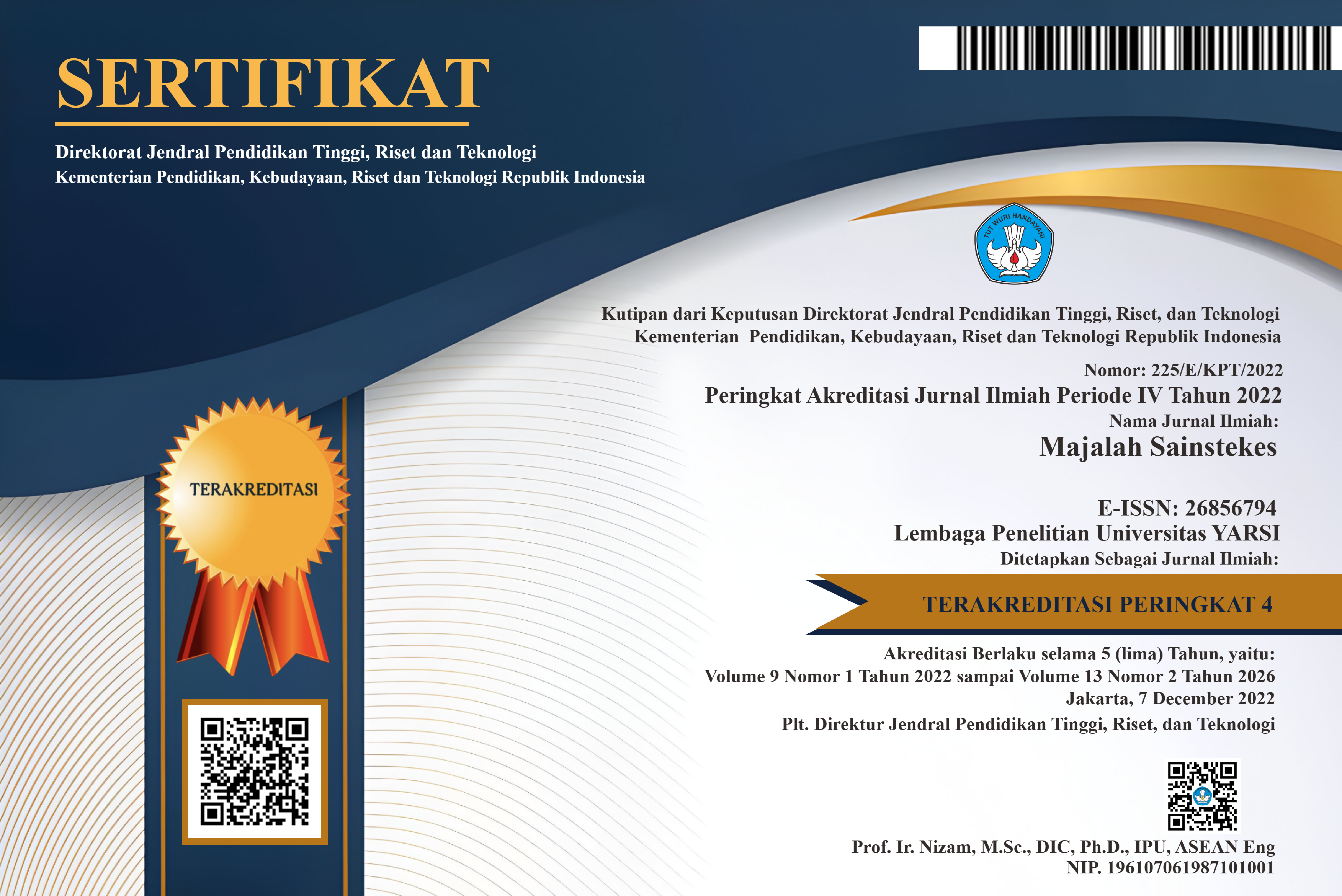Faktor Risiko Early Childhood Caries pada Anak UsiaPrasekolah di PAUD Kenanga 17 Kelurahan Penjaringan, Kecamatan Penjaringan, Jakarta Utara
Keywords:
Dental caries, risk factors of early childhood caries, preschool children, formula milkAbstract
Dental caries is a multifactorial disease that can affect all levels of society. There are several factors that take part ini caries initiation. Caries risk factors in children are related to age, gender, use of bottles, tooth brushing frequency, the role of the mother, and parental education. The purpose of this studywas to find out factors related to the cause of early childhood caries experienced by preschool children at PAUD Kenanga 17 Kelurahan Penjaringan, Kecamatan Penjaringan, North Jakarta. An observational analytical methods with cross sectional approach was used in this study. Subject in this study consisted of 20 children as a total sample of the population. Data collection was carried out using questionnaires and def-t index was employed for dental examination. Data processing and statistical analysis using chi-square test were applied with a significance value of p less than 0.05. The results showed significant correlation between age (p value 0.001) and gander (p value 0.047) andearly childhood caries.hawever, no correlation was observed betwen the use of bottle (p value 0.909), frequency of tooth brushing (p value 1.00), role of mother (p value 1.00), and parental education (p value 0.798) and early childhood caries.References
Azevedo TDP, Bezerra ACB, de Toledo OA 2005. Feeding habits and severe early childhood caries in Brazilian preschool children. Pediatr Dent; 27(1):28-33.
Gofar A, Firmansyah A 2012. Hubungan gigi karies terhadap status gizi anak Tk muslimat 7 peterongan jombang. J.Edu Health;2(2):1-13.
Hasil Riskesdas 2007. Badan penelitian dan pengembangan Kesehatan Kementrian Kesehatan RI; p.130,132.
Hasil Riskesdas 2013. Badan penelitian dan pengembangan Kesehatan Kementrian Kesehatan RI;p.146-7.
Khotima K, Suhadi N, Purnomo 2013. Faktor-faktor yang berhubungan dengan kejadian karies gigi pada anak usia 6-12 tahun di SD Negeri Karangayu 03 Semarang. J Ilmu Keperawatan dan Kebinanan;1(4):1-10.
Kuriakose S, Prasannan M, Remya KC, Kurian J, Srejith KR 2015. Prevalence of early childhood caries among preschool children in Trivandrum and its associated with various risk factors. Contemporary clinic dentistry;6:69-73.
Lombo A, Mayulu N, Gunawan PN 2015. Status karies anak prasekolah citra kasih yang mengkonsumsi susu formula. J.eG;3(1).
Mintjelungan CN 2014. Prevalensi karies gigi sulung anak prasekolah di Kecamatan Malayang kota Manado. J Biomedik;6(2):105-9.
Prasetya RC. 2008. Perbandingan jumlah koloni bakteri saliva pada anak-anak karies dan non karies setelah mengkonsumsi minuman berkarbonasi. Indonesia J.D;15(1):65-70.
Robke FZ 2008. Effects of nursing bottle misuse on oral health prevalence of caries, tooth malalignments and malocclusions in North-German preschool children. J Orofac Orthop;(1):5-19
Subramaniam P, Prashanth P 2012. Prevalence of early childhood caries in 8 – 48 month old preschool children of Bangalore city, South India. Contemporary clinic dentistry;3:15-21.
Sumini, Amikasari B, Nurhayati D 2014. Hubungan Konsumsi Makanan Manis Dengan Kejadian Karies Gigi Pada Anak Prasekolah Di TK B RA Muslimat PSM Tegalrejodesa Semen Kecamatan Nguntoronadi Kabupaten Magetan. J Delima Harapan; 3(2):20-7.
Supariani NN, Artawa IM, Wirata IN 2013. Hubungan karbohidrat pada susu yang dikonsumsi dengan kejadian karies gigi botol pada anak play group. J Kes G;1(1):27-31
Susi, Bachtiar H, Azmi U 2012. Hubungan status sosial ekonomi orangtua dengan karies pada gigi sulung anak umur 4 dan 5 tahun. Majalah Kedokteran Andalas;36(1):96-105.
Wirjayadi, Kadir A, Askar M 2013. Faktor yang berhubungan dengan kerusakan gigi pada anak usia pra sekolah di Tk Kartika XX-1 Makassar. J.Ilmiah Kesehatan;1(6):1-8.
Zafar S, Harnekar SY, Sidiqi A 2009. Early childhood caries: etiology, clinical considerations, consequences and management. Int Dent ;11(4):24-36.

 Anita Rosa Delima
Anita Rosa Delima












